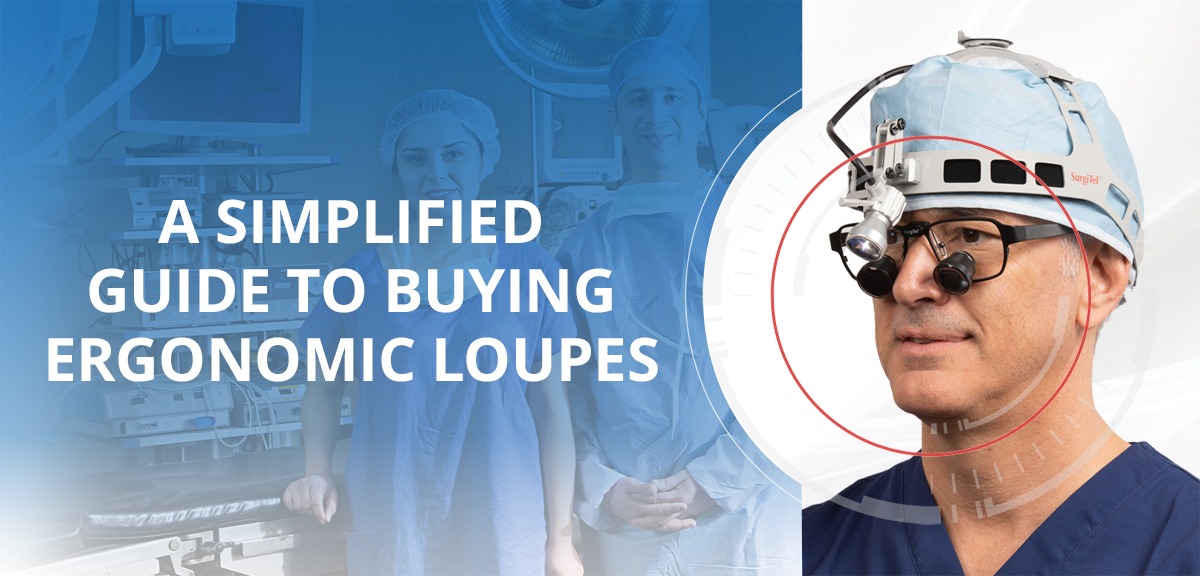A Simplified Guide to Buying Ergonomic Loupes

Practicing proper ergonomics in the workplace can make the difference between a long and comfortable career or a painful early retirement. For clinicians who use loupes, this guide can ensure you’re considering the three key factors in selecting ergonomically correct loupes for you, so you can continue to perform your best work, without pain, long into the future.
Head Tilt Angle
The principal factor in determining your ergonomically correct working posture while wearing loupes is your head tilt angle. To avoid chronic back, shoulder and neck pain or injury, your working head tilt angle should be no more than 20-degrees*.
Determining your head tilt angle is simple. This can be accomplished with two photos of your side view and a protractor. (Figure 1).

Fig. 1. Neutral neck posture vs. working neck posture with loupes
The first photo of your side view should be taken while in your neutral neck posture. The second photo should be of your side view while wearing loupes and in your working posture. Using the protractor, measure the angle of your neutral neck posture, then measure the angle of your working posture with loupes. If your neutral neck posture angle is anything other than 0-degrees, deduct that number from your working posture neck angle; the result is the degree of your head title angle. If your head tilt angle exceeds 20-degrees beyond your neutral posture, your loupes are ergonomically incorrect for you.
Need help with your loupe measurements? Contact SurgiTel® to request a free evaluation at your practice.
Declination Angle
The declination angle of loupes is the measurement of how well loupes allow you to look downward* at your subject. Loupes with steeper declination angles provide magnification with reduced neck flexion, which is the principal goal in avoiding pain from maintaining an improper working posture.
It is best to determine your optimal declination angle while wearing loupes, as your facial features will play a factor in finding your accurate measurement. This can be accomplished by using the neutral posture photo from earlier to measure your body posture angle, reference line angle and the maximum rotation angle of your eyes required to see your subject (Figure 2).
In the example provided in Figure 2, the clinician’s posture angle is 25-degrees and reference line angle is 12-degrees, making the maximum rotation angle required for his eyes to see the subject 53-degrees.

Fig. 2. Finding the optimal declination angle
An additional consideration while selecting your loupes is that eyes must rotate down the full declination angle while wearing straight loupes. But since deflection loupes are already at a 40-degree angle, your eyes will be required to rotate fewer degrees. For example, if you wanted a 45-degree declination angle with deflection loupes, your eyes would only need to angle down 5-degrees and the loupes would do the rest.
Get more details on determining your custom declination angle in ErgoPractice News.
Working Distance
The next measurement to obtain in determining your ergonomically safe working posture with loupes is your working distance. Working distance is the length between your loupes and the subject area. Your working distance measurement can easily be determined with a tape measure (Figure 3).

Fig. 3. Working distance measurement
While positioned with your ideal head tilt angle, place the tape measure on the bridge of your nose where your loupes rest and measure the distance to your working area on your subject. You now have the measurement for your working distance. Keep in mind that the longer your working distance, the higher loupe magnification power you will need to obtain optimal visibility.
Change your working distance for varying procedures or increase your reading Rx power with working distance caps from SurgiTel®.
How can you ensure your loupes are truly ergonomic?
Choose SurgiTel loupes, the only truly ergonomic loupes on the market. If you need help determining your measurements for your customized loupes or want more tips on buying ergonomic loupes, contact SurgiTel to request a free consultation. We’ll bring our loupes to you, determine your ideal measurements and fit you for your perfect loupes.
*Valachi B, Practice dentistry pain-free, Posturedontics Press, Portland, OR, 2008, posturedontics.com


